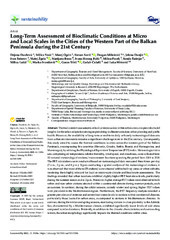Приказ основних података о документу
Long-Term Assessment of Bioclimatic Conditions at Micro and Local Scales in the Cities of the Western Part of the Balkan Peninsula during the 21st Century
| dc.creator | Đurđević, Dejana | |
| dc.creator | Vasić, Milica | |
| dc.creator | Ogrin, Matej | |
| dc.creator | Savić, Stevan | |
| dc.creator | Milošević, Dragan | |
| dc.creator | Dunjić, Jelena | |
| dc.creator | Šećerov, Ivan | |
| dc.creator | Žgela, Matej | |
| dc.creator | Marijana, Boras | |
| dc.creator | Herceg Bulić, Ivana | |
| dc.creator | Pecelj, Milica | |
| dc.creator | Šušnjar, Sanda | |
| dc.creator | Lukić, Milica | |
| dc.creator | Ivanišević, Marko | |
| dc.creator | Trbić, Goran | |
| dc.creator | Ćulafić, Golub | |
| dc.creator | Mitrović, Luka | |
| dc.date.accessioned | 2023-11-01T15:47:02Z | |
| dc.date.available | 2023-11-01T15:47:02Z | |
| dc.date.issued | 2023 | |
| dc.identifier.issn | 2071-1050 | |
| dc.identifier.uri | http://gery.gef.bg.ac.rs/handle/123456789/1517 | |
| dc.description.abstract | Thermal comfort assessments at local or micro-scales within urban areas can provide crucial insights for the urban adaptation strategies pertaining to climate-conscious urban planning and public health. However, the availability of long-term or mid-term daily or hourly meteorological data sets from urban environments remains a significant challenge even in the 21st century. Consequently, this study aimed to assess the thermal conditions in cities across the western part of the Balkan Peninsula, encompassing five countries (Slovenia, Croatia, Serbia, Bosnia and Herzegovina, and Montenegro), by utilizing the Physiological Equivalent Temperature (PET) index. Meteorological data sets, comprising air temperature, relative humidity, wind speed, and cloudiness, were collected from 32 national meteorological stations/measurement locations spanning the period from 2001 to 2020. The PET calculations were conducted based on meteorological data measured three times per day (7 a.m., 2 p.m., and 9 p.m.). Upon conducting a spatial analysis of the meteorological stations, it was observed that most of them (25 stations) were situated within built-up areas or urban suburbs, rendering them highly relevant for local or micro-scale climate and bioclimate assessments. The findings revealed that urban locations exhibited slightly higher PET heat stress levels, particularly during the summer season and at 2 p.m. Moreover, higher average PET values were observed in both urban and non-urban stations situated within a continental climate during warmer periods, such as summer. In contrast, during the colder seasons, namely winter and spring, higher PET values were prevalent in the Mediterranean region. Furthermore, the PET frequency analysis revealed a greater prevalence of extreme and severe heat stress levels in stations within continental climates, particularly those located in urban areas, as compared to stations in Mediterranean climates. In contrast, during the winter and spring seasons, monitoring stations in close proximity to the Adriatic Sea, characterized by a Mediterranean climate, exhibited significantly lower levels of cold stress compared to inland stations. Evidently, in addition to the climatic characteristics and surrounding terrain, the urban morphology significantly impacts the thermal conditions within cities. | sr |
| dc.language.iso | en | sr |
| dc.publisher | Basel : MDPI | sr |
| dc.relation | info:eu-repo/grantAgreement/MESTD/inst-2020/200125/RS// | sr |
| dc.relation | Croatian Science Foundation under the project HRZZ-UIP-2017-05-6396 (CroClimGoGreen) | sr |
| dc.relation | Croatian Science Foundation (HRZZ-DOK-2021-02-9704) | sr |
| dc.rights | openAccess | sr |
| dc.rights.uri | https://creativecommons.org/licenses/by/4.0/ | |
| dc.source | Sustainability | sr |
| dc.subject | bioclimate | sr |
| dc.subject | outdoor thermal comfort | sr |
| dc.subject | PET | sr |
| dc.subject | microclimate | sr |
| dc.subject | urban area | sr |
| dc.subject | Balkan Peninsula | sr |
| dc.title | Long-Term Assessment of Bioclimatic Conditions at Micro and Local Scales in the Cities of the Western Part of the Balkan Peninsula during the 21st Century | sr |
| dc.type | article | sr |
| dc.rights.license | BY | sr |
| dc.citation.volume | 15 | |
| dc.citation.issue | 21 | |
| dc.citation.spage | 15286 | |
| dc.citation.rank | M22 | |
| dc.identifier.doi | 10.3390/su152115286 | |
| dc.identifier.fulltext | http://gery.gef.bg.ac.rs/bitstream/id/3369/sustainability-15-15286-v3.pdf | |
| dc.type.version | publishedVersion | sr |


